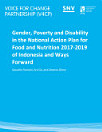Nutrition-sensitive social protection programs within food systems
Tentang eBook ini
Investments in social assistance programs (SAPs) in low- and middle-income countries (LMICs) are increasing. As investments increase, the objectives of these programs are expanding from focusing on reducing poverty to addressing other social issues such as improving diets and nutrition. At the same time, there is increasing interest in addressing all forms of malnutrition within the framework of food systems. Given the intersections between SAPs and food systems, we reviewed the effectiveness of SAPs (agriculture asset transfers, cash transfers, in-kind transfers, vouchers, public works and school meals programs) for reducing all forms of malnutrition across the lifecycle within a food systems framework. As several programs included multiple treatment arms, each representing a unique program design, we used study arm as the unit of analysis and assessed the proportion of study arms with positive or negative program impacts on diet and nutrition outcomes among men, women and children. The majority of the studies included in this review were from evaluations of agriculture asset, cash and in-kind transfer programs. There was clear evidence of positive impacts on women’s and children’s diet-related outcomes. Very few studies assessed program impact on women’s nutritional status outcomes. However, there was some evidence of impacts on increasing body mass index and hemoglobin concentration (Hb) with in-kind transfer programs. Among children, several study arms across the agriculture asset, cash and in-kind transfer programs found positive impacts on increasing height-for-age Z-score (33%-45% of study arms) and weight-for-height Z-score (33%-50% of study arms) and decreasing the prevalence of wasting (43%-60% of study arms). Cash and in-kind transfer programs also found positive effects on reducing stunting prevalence in 33% and 45% of study arms, respectively. Lastly, a few study arms assessed program impact on increasing Hb with some evidence of positive impacts in in-kind and school feeding programs. There was a paucity of relevant evidence of the effectiveness of voucher and public works programs on diet and nutrition outcomes, for men’s outcomes and on micronutrient status. Several challenges remain in understanding the potential for SAPs to improve diet and nutrition outcomes within food systems including the heterogeneity of program and evaluation designs, populations targeted by the programs and included in evaluations and indicators used to assess impact. Addressing these challenges in future evaluations is important for informing program and policy actions to improve the effectiveness of SAPs within food systems for improving diet and nutrition outcomes across the lifecycle.






